The Little Mermaid (1989)
Kevin:
Frozen is largely credited for creatively twisting Disney princess tropes, but for me, The Little Mermaid did it better. Although it returned to the animation Disney was known for in the golden days, The Little Mermaid should be known for innovating the Disney fairytale formula. Eric and Ariel fall in love at first sight, but then they have to build their relationship from the ground up until voiceless Ariel matches the mysticism of his fantasy girl. And its heroine doesn’t wait around for her prince charming to come and save the day. Ariel gets a pair of legs to go get her man.
While the Disney experience always involved their characters singing some songs, The Little Mermaid marked a deep philosophical change within the studio. Alan Menken and Howard Ashman not only started reviving the Broadway musical with their The Little Shop of Horrors, they also revived the movie musical. The Little Mermaid just happens to be animated.
The Little Mermaid meshes the best of Disney animation and the Broadway stage to give the studio their first hint of an identity since Walt Disney’s passing. Many Disney films have since tried to recapture the fun, up-beat atmosphere of The Little Mermaid, but only one has exceeded its tuneful spirit, innocent storytelling, and artistic merits. Rarely is a movie’s influence on its genre more profound than The Little Mermaid’s. It’s easy to see why.
Verdict: Properly Rated
Kevin’s Favorite Moment: ♪Bright young women/sick of swimming/ready to stand!♪
Dan:
The Little Mermaid is the third-most important animated movie of all time (behind Snow White and Toy Story). It’s so good at what it does that it set a template for animated movies — spirited, Broadway-style musicals — that went unquestioned for more than half a decade, until Woody first uttered “You’re my favorite deputy.” It’s known as a true classic, and it IS a true classic.
Verdict: Properly Rated
Dan’s Favorite Moment: “Under the Sea”
Beauty and the Beast (1991)
Dan:
There are some good reasons you could call Beauty and the Beast the most acclaimed animated movie of the past quarter century. I’d go even farther and call it a contender for the greatest animated movie ever.
B&tB is a true delight, a fantastic success on virtually every level. It has the greatest villain in Disney history (sorry, Hades), a wonderful hero and heroine, lovable side characters, fantastic music, beautiful animation, and a story filled with conflict and adventure and romance and comedy. It’s just a tour de force of entertainment for kids and adults, boys and girls.
So few of the characters seem like they’re shoehorned in for the sake of advancing the plot. Everyone has their own motivations: Shallow, stubborn Gaston wants to marry the prettiest girl in town. Beast wants to break the spell, but falls for Belle anyways. Etc. This movie is full of marvelous storytelling, and that’s the source of its magic.
This remains a gold standard for animated movies, and few (if any) films have ever met that standard.
Verdict: Properly Rated
Dan’s Favorite Moment: “I’m especially good at expectorating”
Kevin:
I’m going to take Dan’s claim one step further and say Beauty and the Beast is THE best animated film of all time. It has defined the studio for decades to come. Princess and the Frog, Tangled, and Frozen all borrow elements from Beauty and the Beast, making their female lead drastically different than her love interest. What these films haven’t captured is the struggle. I’ve always found Disney’s two leads warming up to one another much too quickly. Beauty and the Beast is all about the struggle. The struggle of both Belle and the Beast to choose love over their dreams. In the end, hardworking and the spoiled, innocence and the cunning, extrovert and the introvert, all have much to owe to the truly enchanting and essential Beauty and the Beast.
Verdict: Properly Rated
Kevin’s Favorite Moment: The Beast’s transformation
Aladdin (1992)
Dan:
I watched Aladdin for the first time in a couple years last week. I’ve always ranked this movie as the least of Disney’s biggest four films from the late ’80s and early ’90s (this, Beauty, Lion King, and Mermaid). But now I’m not convinced that it’s any less enjoyable than Mermaid or The Lion King.
Aladdin is a story about two teenagers who desperately want to escape their limiting lives.They fall for each other in part because they have obvious chemistry (and are attractive and single), and in part because each sees freedom in the other. Aladdin has no walls; he can go where he pleases, but he has to scramble to survive each day. Jasmine has unlimited wealth and comfort and leisure, but no freedom to do what she wants. Both have what the other thinks they want.
And all of that comes before we meet The Genie voiced by Robin Williams, my pick for Disney’s greatest character. He’s hilariously voiced and imaginatively animated, but has his own depth: He’s a prisoner, just like Aladdin and Jasmine.
Throw in my favorite Disney song (“A Whole New World”) and some of Disney’s most entertaining sidekicks (Iago, Abu), and you have an animated masterpiece. The movie’s been a bit devalued in recent years thanks to its reliance on slapstick and pop culture references. AFI left it off their list of the ten best animated movies, but it would likely place in my own top ten animated movies.
Verdict: Underrated
Dan’s Favorite Moment: Jasmine turns “A Whole New World” into a duet
Kevin:
Not to get ahead of myself, but Aladdin is Shrek done correctly. In fact, its success probably ushered in the age of animation where famous actors are hired to do the voices. Aladdin’s influence on the animation landscape can be seen through the entire DreamWorks arsenal, which also relies more heavily on pop-culture references. While I don’t particularly like the direction Aladdin nudged animation, watching Robin William’s performance makes it understandable. Unbounded by the laws of reality, he brings the Genie to life, stealing practically every scene he’s in with his animated personality.
But as Dan points out, even the Genie is given depth, giving Aladdin a sense it was deeply cared for. I just think Disney loosened up a bit this time around. Aladdin has lost favor with most critics who now largely view Aladdin behind The Little Mermaid, Beauty and the Beast, and The Lion King, and I think this is because Aladdin simply doesn’t have the timeless feeling of a genuine masterpiece. Aladdin misses my top ten list, but barely.
Verdict: Properly Rated
Kevin’s Favorite Moment: Aladdin’s “One Jump Ahead” reprise
The Lion King (1994)
Kevin:
Riding off of the success of The Little Mermaid, Beauty and the Beast, and Aladdin, The Lion King somehow manages to escape unscathed by critics and fans alike. Even more shockingly, the main writer of Beauty and the Beast is on the writing team of The Lion King. The screenplay is so bad that it immediately questions whether her work on Beauty and the Beast was a fluke.
The Lion King traces the life of Simba, an undeserving heir to throne who somehow becomes deserving by befriending the manipulative Timon, getting hit in the head by a stick-wielding baboon, and hallucinating his dad up in the clouds. Scar, on the other hand, becomes hyena meat after trying to feed them. Oh, the irony. It’s a shame Pride Rock had to experience what has to be one of the worst droughts ever during Scar’s rule, otherwise the plot wouldn’t require Simba to become king and regain control of the weather.
Worst of all, The Lion King basically rips off Bambi, removing a layer of originality some people like to associate with The Lion King. In the wake of Ashman’s death, the Disney crew of Beauty and the Beast would never work as a whole again after Aladdin. The A-team worked on Pocahontas. The B-team worked on The Lion King.
Even insiders believed The Lion King would tank. The Lion King‘s unprecedented success was about as unlikely as the absurb amount of rain that accompanies Simba’s reign. Even then, the lion king never convincingly finds his roar.
Verdict: Overrated
Kevin’s Favorite Moment: Scar kills Mufasa
Dan:
I have to strongly disagree with Kevin. He raises some good points about questionable plot elements and characterization used in The Lion King, but even acknowledging these, I consider the film a resounding success. As we learned with Frozen two decades later, a fantastic soundtrack will forgive a lot of other deficiencies in a film, and The Lion King‘s soundtrack is, pound-for-pound, Disney’s best ever (all five numbers are all-time classics).
But I also quite enjoy the story and the sense of adventure. The animation is lush and stunning, the spiritual-mythical sense of gravitas adds drama, and the plot is full of winning moments. The retelling of the Hero’s Journey makes the story feel timeless, and I still love this movie.
Verdict: Properly Rated
Dan’s Favorite Moment: “Why won’t he be the king I know he is, the king I see inside?” transitioning into the chorus of “Can You Feel the Love Tonight”
Pocahontas (1995)
Dan:
There are parts of Pocahontas I like, but I also find it the most objectionable film of Disney’s “renaissance” of 1989-1999. In fact, I would even say Pocahontas is borderline immoral in its depiction of Native Americans as tree-huggers. It’s one thing to misrepresent a myth of a lost civilization (Hercules) — which is something I’ve heard people complain about way more than the depiction of Native American culture in Pocahontas — but another to stereotype a whole (still existing) culture with a few broad strokes.
It might be a little bit easier to swallow if the movie didn’t take itself so damn seriously, pounding home its morals of equality and environmentalism, but the whole affair is clunky and didactic. None of the characters really light up the screen and entertain the way Genie or Lumiere do.
The romance between Pocahontas and John Smith lacks spark, the raccoon and pug sidekicks are annoying, and the whole talking tree thing feels like the writers ripped off the most boring 10% of The Lion King. The villain somehow manages to be both non-menacing and boringly evil, and Pocahontas herself projects few likable traits, caring more about a lover she barely knows than her friends and family. (Her major redeeming trait is her gorgeous character design, one of my favorites in all of animation.)
“Colors of the Wind” is truly stunning, but it takes more than a great music video to overcome an otherwise troublesome film. Give me “the struggle,” as Kevin noted. Don’t just tell me what the point of the struggle is… make me feel it.
Lines like “These pale visitors are strange to us. No one is to go near them!” sound as if they were written in a high school English class, and the mere fact that Disney opted to cut out the scene where its leads fall in love because test audiences found it “boring” shows you how misguided some of the thinking behind this film was.
Verdict: Overrated
Dan’s Favorite Moment: When Pocahontas stole a cub from her mama bear during “Colors of the Wind,” I was momentarily hopeful that Pocahontas and John Smith would be mauled and we’d be spared the rest of the movie
Kevin:
I’m surprised the whole movie wasn’t cut out due to test audiences.
For everything The Lion King wasn’t, at least it was dramatic. It fell off a cliff trying to climb it. Pocahontas sits passively at the bottom, re-using every cinematic trope that flies their way, hoping its artistic merits masks its non-story. Hey look, we have a romance! Didn’t you like that in Beauty and the Beast? Hey look, we have side characters! Didn’t you like that in The Little Mermaid? Hey look, we have one good song! Let’s just throw in a few more to make it a musical. At this point, success was the norm for Disney, and they were just following a seemingly infallible check-list. Even Superman has his kryptonite.
After the downfall that was The Lion King and Pocahontas, Disney would never find its footing again until the 21st century. I think critics were so disillusioned by Disney’s earlier works that they swallowed Pocahontas pretty well. Over time, Pocahontas’ true colors has been exposed.
Verdict: Properly Rated
Kevin’s Favorite Moment: John Smith waves goodbye in Powhatan
The Hunchback of Notre Dame (1996)
Kevin:
You can tell this was produced by directors Gary Trousdale and Kirk Wise who forever left their imprint on cinema with Beauty and the Beast. There is an ugly, disfigured male protagonist in Quasimodo. There is once again a love triangle, except this time the good-looking Phoebus wins over the heart of beautiful gypsy girl, Esmeralda. The animation makes Notre Dame feel like its the Eiffel Tower of Paris, perfectly capturing the scope of Quasimodo’s world. Menken is still at his best, returning to do the soundtrack.
This is where the comparisons to Beauty and the Beast comes to a screeching halt.
The glowingly warm ensemble of household items have been replaced by Disney’s most distracting side characters, the thee gargoyles. Their song,” A Guy Like You,” is so cartoonish that it feels like its been pasted onto this feature from a sequel made by DisneyToon studios. The undercurrent of darkness first found in the Beast’s tragic story is now at full blast, undermining Quasimodo’s character and morphing him into a blatant sympathetic character who, despite being the title character, oftentimes sits second to more interesting characters like Frollo.
The movie takes after Follo, who is Disney’s most dastardly villain to date. This movie depicts society as cruel and mean-spirited, and actually, I think the movie is cruel and mean-spirited. Whereas Beauty and the Beast expertly weaved around mature topics such as bestiality, Stockholm syndrome, and alcoholism, The Hunchback of Notre Dame criticizes mob-mentality, religion, and sexual lust, leaving the bleak impression that everyone is as deformed as this movie.
Verdict: Properly Rated
Kevin’s Favorite Moment: Quasimodo duets with Frollo in “Out There”
Dan:
See, I actually appreciate that the movie is so dark. Unlike Disney’s other serious-minded movie from the era, Pocahontas, Hunchback actually manages to feel emotionally intense rather than dull. The serious tone here lends the movie an air of horror and gravitas. I like the idea of a Gothic Disney movie.
I do think Quasimodo, ironically, ended up a bit shallow. He needed a bit more development to stand out. But, without question, the Gargoyles are easily the worst part of this movie. They’re like an escape hatch from the tension and drama, making sure the movie never builds too much momentum before we get a blast of wacky.
But, man, when this movie hits, it hits hard. The film’s direct confrontation of the innate good and evil in people could have gone wrong so many places, but it almost never does. The “God Help the Outcasts” sequence might be the most underrated moment in any Disney movie, and I still get chills listening to “Hellfire.” Such villainy. No movie defied Disney’s warm streak and fairy tale tropes better than this, and for that, I am infinitely glad it exists.
Verdict: Underrated
Dan’s Favorite Moment: The choral section of “God Help the Outcasts”
Hercules (1997)
Kevin:
After receiving the complaints following Pocahontas, Disney would never quite strike the balance that made their earlier “Renaissance” movies so good. Both Pocahontas and The Hunchback were more serious adaptations, and with Hercules, they seem to overcompensate by loading the film with comic relief characters, a gospel choir for the sake of explaining exposition, and one-note protagonists.
Hercules’ character arc runs exactly as you would expect it to; Phil is the resentful mentor who we’ve seen done many times over; Meg is the sassy, quick-witted romantic interest who the protagonist instantly falls in love with. Except, Meg is given a back-story which actually injects some potential into this story for adults. Meg is basically a slave for villain Hades because she bargained with him to save her boyfriend’s life, only for him to run away with another woman. Had this not been casually glossed over in the film’s fast, sporadic pacing, Hercules could have been a great movie. As it is, Hercules has enough colors, songs, and jokes to entertain the kiddie demographic.
Verdict: Properly Rated
Kevin’s Favorite Moment: Megara sacrifices her life for Hercules
Dan:
Hercules is a joyride of a movie, full of comedy and slapstick, and retaining a great rewatchability because of it. (Number of times I’ve thought “I kinda want to watch Pocahontas“: 0. Number of times I’ve thought “I kinda want to watch Hercules“: 100+.)
Meg is one of Disney’s all-time intriguing characters, but I agree with Kevin that her backstory could have been fleshed out a little bit more. The real show-stealer, though, is the sarcastic Hades who I was almost rooting for by the end of the movie.
Throw in unique character designs and a rambunctious soundtrack, and you’ve got a gem.
Verdict: Underrated
Dan’s Favorite Moment: “That’s Phil’s boy!”
Mulan (1998)
Dan:
I’ve always found Mulan to be a very charming movie. It’s not perfect, and Eddie Murphy as Mushu has always stuck out as a little jarring when I’ve watched the movie recently, but it’s definitely charming.
Mulan is a really fascinating movie to watch from the perspective of gender norms. You often hear media talk of which Disney princesses are “feminist figures,” and Mulan has always struck me as the most obvious example. Like many modern Disney princesses, she takes personal agency — but, like few, her mission has nothing to do with falling in love. (That’s just a convenient side effect.)
But if it wasn’t for the great sense of humor and adventure, Mulan wouldn’t work. And Mulan has these in spades: Mulan goes through a gauntlet of obstacles and turmoil, from her doomed encounter with the matchmaker, to her training, to her battle with the Huns, to her final victory over Shan Yu, Disney packs a long quest and a lot of self-discovery into 90 minutes. And the script is really funny, too; Mushu has plenty of great moments, and Mulan’s “don’t-give-a-f***” grandmother is even better.
It’s not quite the peaks of Aladdin or Beauty and the Beast — the Chinese New Year climax lacks the impact of the rest of the movie, in my opinion — but it’s an exciting and extremely entertaining film packed with great music, characters, and story. And if I ever have a daughter, this’ll be one of the first Disney movies I show her.
Verdict: Properly Rated
Dan’s Favorite Moment: “The greatest gift and honor is having you for a daughter”
Kevin:
“Funny, exciting [and] entertaining” doesn’t quite have the same ring as enchanting, magical, and timeless. Neither does Mulan. Mulan is like a clay pot. Sturdy, reliable, durable, and tested, but lacking shine. You know Mulan will entertain, but fail to amaze. I’m giving my wife a glass vase.
Although many people who claim they are acute to story like to classify Mulan as underrated, these same people seem to give a pass on the flawed ending in which Mulan is basically doomed to a life as Shang’s house-wife. I’m not too agitated by this mainly because I think Mulan will divorce him if things don’t work out.
Mulan’s real strength lies in its main character and slapstick humor. Mulan’s character growth is interesting and feels natural. I love Mulan’s three buddies, and “A Girl Worth Fighting For” is as funny as Disney songs get, second to only “Gaston.”
And as shallow as I’m going to sound for saying this, I just wished Mulan looked better (barring the avalanche scene). Mulan herself looks flat and I rarely find myself admiring any of the backgrounds. There’s a real gem in “Reflection” which got unjustly shortened, revealing where Disney wanted to go with this production–less drama, more jokes. The now-shaky Disney studio just didn’t have the confidence to take Mulan more seriously.
Verdict: Properly Rated
Kevin’s Favorite Moment: Mulan retrieves an arrow from a pole in “I’ll Make a Man Out of You”
Tarzan (1999)
Kevin:
Tarzan represents an awkward crossroad for the studio. No longer reaping the rewards of animated outings like Beauty and the Beast and Aladdin, Disney with Tarzan willingly deviates from the “Disney Renaissance” template. No characters sing in this one. There is no princess. This isn’t a fairytale.
Yet, it carries the obligatory baggage of the Disney necessities, such as romance and the unsubtle villain. Side characters still remain, but after a long succession of annoying ones (Timon, Gargoyles, Pain and Panic, Mushu), Tarzan finally gets it right with Tantor and Terk. I think what makes them stand out is that they aren’t written like… well, side characters. Both are injected with stand-alone personalities and have a dynamic with Tarzan resembling more of friendship than partnership. This friendship, along with the special effects supplementing the kinetic animation, are the real highlights of Tarzan.
Phil Collins doing the songs, the romance between Tarzan and Jane, and the not-so-surprising reveal of the villain are simply mediocre story elements. Disney would be rightly rewarded for taking risks with Tarzan, but I argue it could have scrapped out more of the typical Disney stuff to focus more on the tension between Tarzan, Kerchak, and the rest of the gorilla family. Probably the biggest downfall of Tarzan is that it does just enough to remind us of how good Disney’s earlier works were.
Verdict: Properly Rated
Kevin’s Favorite Moment: Tarzan meets a human being for the first time
Dan:
I read a fair amount of books about creative writing, and there’s a cliche that repeatedly pops up: “A story is only as good as its villain.” It’s not an infallible rule, but if I were to rank the nine movies in this article and rank the nine villains from said movies, the order would be almost exactly the same: Gaston and Jafar at the top, Clayton and Ratcliffe at the bottom.
That’s not to say I dislike Tarzan at all. I love the animation, the scenes of Tarzan interacting with his friends and ape family, and the way Jane and Tarzan grow closer and closer, even if the latter happens a bit too easily. Come to think of it, I like most of Tarzan except the main conflict. I kept wanting to watch more of Tarzan being a normal ape-man or a mismatched lover.
Tarzan is hailed as being a peer to the rest of the Disney Renaissance, and while it’s excellent, I don’t quite categorize it there. The music and the plot don’t quite do it for me, and I’m not as won over by Tantor and Terk as Kevin is.
Verdict: Overrated
Dan’s Favorite Moment: Same as Kevin – Tarzan and Jane meeting
[wp_biographia user=”kevin”]




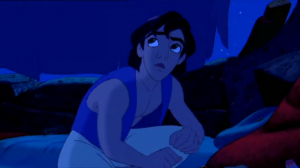
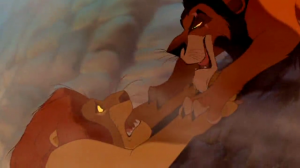
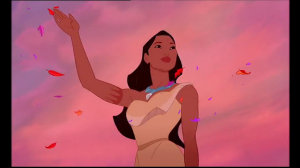
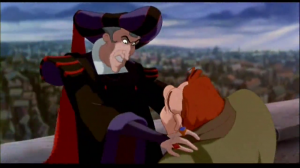
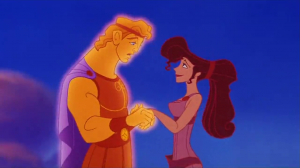
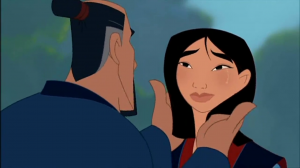
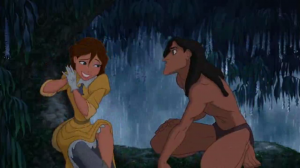



I watched “Hunchback” a year or so ago after not having seen it since the 90s, and was really impressed. I don’t even mind the gargoyles: If you view it from the angle that they’re figments of Quasi’s imagination, it actually ADDS to the darkness of the film – the cheeriest characters don’t actually exist. “A Guy Like You” is Quasimodo daring to view himself as romantically viable…plus, they managed to rhyme “Adonis” with “croissant is”, possibly my favorite rhyme since the “specimen” line in “Gaston.”
One final thought: I really hoped I’d get to talk about “Strangers Like Me” in the Top 50 article. I love the “magic lantern” and Victorian-style illustrations intercut with Tarzan’s education “in the field.” There are a lot of great “getting strong” montages in the annals of cinema…but this might just be the best “getting smart” one.
Interesting take on the Gargoyles.
I’ve been listening to “Strangers Like Me” a lot recently — good song. I’ll have to watch Tarzan again soon to see if it’s time to bump this up to “properly rated.”
At first I thought that’s where Disney was going with the gargoyles, especially since Frollo asks Quasimodo if he’s talking to the gargoyles again, reminding him that gargoyles can’t talk. But then you have the ending battle where the gargoyles actually assists Quasimodo in defending the church from Frollo’s guards. In any case, I’m glad you enjoyed Hunchback. There’s certainly lots to like.
Note to Dan: How is Gaston the best Disney villain? I mean, he’s not a weak villain, but, IMO, he doesn’t compare to villains from the likes of Maleficent, Scar, Cruella de Vil, Frollo, Ursula or Jafar. I do agree with your thoughts on Hunchback, though.
Note to Kevin: How is Scar killing Mufasa your favorite moment in the film? What about the Circle of Life opening?
There are some other good candidates — Scar, Jafar — but Gaston is king among the villains, in my opinion. Villains are usually ugly, cackling schemers — Gaston defies these. I like that his main goal is not overtly malicious — he wants to marry the prettiest girl. His entitled, selfish, womanizing attitude felt semi-authentic (surely you know guys who similarly view woman as basically hunting game). Yet his transition to jealous, vicious killer never felt out of place: Gaston’s violence and selfishness are the opposite of Beast’s selfless love (a juxtaposition of their natural looks). It just works so well.
But mostly it’s the song.
I agree with those points, but I think a lot of the same could be said for Prince Hans from Frozen (the only real difference being that he was evil from the start, just unbeknownst to the characters and audience, while Gaston becomes progressively more evil as the film progresses).
I use antlers in all of my decorating!
My what a guy-GASTOOOON!
I was trying to be slightly snarky with my The Lion King favorite moment, as I was picking Pocahontas’, but maybe it would be more obvious if I said, “When Scar kills off the only character who could have taught Simba how to be king.” To know why it is my favorite moment, I should have probably worded it as, “When Disney takes a risk by killing off such a powerful character.” Don’t get me wrong, Circle of Life is great, too, but there wasn’t a particular moment in the number that stood out. As you’ll notice, any time I pick a song as my favorite moment, I was pretty specific to what part of the song I am referring to, otherwise, I think this list would be filled with musical numbers haha.
I see. Objection withdrawn.
Well, I am a taestfulreviews fan, so I am new here. Nice to meet you Dave. I am about to publish my own reviews of the Disney Renaissance in about a week or so, so this is a nice refresher.
I have to say, I agree with many of the criticisms and points you both made; even for the ones that I do like and you two don’t. I too agree that Lion King is a bit overrated, as I could never really connect to it; even from when I was very little. If you look at when these films started production, and what took place in the studio and the animation world at that time, you can find a lot of the issues with the films, and why things started going downhill for them.
TLM: Started in 1985
BatB: 1987
Aladdin: 1987/88
Lion King: 1988
Pocahontas: 1990
Hunchback: 1992/93
Hercules and Mulan: 1994
Tarzan: 1995
It is a good era, but every era ends.
Hey Animated Kid, glad you came to visit Earn This. There are a bunch of great articles here. I’ve listed two down below that you might be interested in.
http://earnthis.net/dans-top-100-everything-27-disney-renaissance/
http://earnthis.net/top-50-disney-songs/
I can’t wait for your reviews on the Disney renaissance!
I am looking forward to reading these articles. So that is what you look like behind the computer screen? The mystery has been solved. I will check the articles soon.
Keep up to date with ALL the FOOTBALL news, gossip, transfers and goals plus fixtures, results and l.